Ting Dang
HealthSLM-Bench: Benchmarking Small Language Models for Mobile and Wearable Healthcare Monitoring
Sep 08, 2025Abstract:Mobile and wearable healthcare monitoring play a vital role in facilitating timely interventions, managing chronic health conditions, and ultimately improving individuals' quality of life. Previous studies on large language models (LLMs) have highlighted their impressive generalization abilities and effectiveness in healthcare prediction tasks. However, most LLM-based healthcare solutions are cloud-based, which raises significant privacy concerns and results in increased memory usage and latency. To address these challenges, there is growing interest in compact models, Small Language Models (SLMs), which are lightweight and designed to run locally and efficiently on mobile and wearable devices. Nevertheless, how well these models perform in healthcare prediction remains largely unexplored. We systematically evaluated SLMs on health prediction tasks using zero-shot, few-shot, and instruction fine-tuning approaches, and deployed the best performing fine-tuned SLMs on mobile devices to evaluate their real-world efficiency and predictive performance in practical healthcare scenarios. Our results show that SLMs can achieve performance comparable to LLMs while offering substantial gains in efficiency and privacy. However, challenges remain, particularly in handling class imbalance and few-shot scenarios. These findings highlight SLMs, though imperfect in their current form, as a promising solution for next-generation, privacy-preserving healthcare monitoring.
E-BATS: Efficient Backpropagation-Free Test-Time Adaptation for Speech Foundation Models
Jun 08, 2025Abstract:Speech Foundation Models encounter significant performance degradation when deployed in real-world scenarios involving acoustic domain shifts, such as background noise and speaker accents. Test-time adaptation (TTA) has recently emerged as a viable strategy to address such domain shifts at inference time without requiring access to source data or labels. However, existing TTA approaches, particularly those relying on backpropagation, are memory-intensive, limiting their applicability in speech tasks and resource-constrained settings. Although backpropagation-free methods offer improved efficiency, existing ones exhibit poor accuracy. This is because they are predominantly developed for vision tasks, which fundamentally differ from speech task formulations, noise characteristics, and model architecture, posing unique transferability challenges. In this paper, we introduce E-BATS, the first Efficient BAckpropagation-free TTA framework designed explicitly for speech foundation models. E-BATS achieves a balance between adaptation effectiveness and memory efficiency through three key components: (i) lightweight prompt adaptation for a forward-pass-based feature alignment, (ii) a multi-scale loss to capture both global (utterance-level) and local distribution shifts (token-level) and (iii) a test-time exponential moving average mechanism for stable adaptation across utterances. Experiments conducted on four noisy speech datasets spanning sixteen acoustic conditions demonstrate consistent improvements, with 4.1%-13.5% accuracy gains over backpropagation-free baselines and 2.0-6.4 times GPU memory savings compared to backpropagation-based methods. By enabling scalable and robust adaptation under acoustic variability, this work paves the way for developing more efficient adaptation approaches for practical speech processing systems in real-world environments.
Token-Level Logits Matter: A Closer Look at Speech Foundation Models for Ambiguous Emotion Recognition
May 24, 2025Abstract:Emotional intelligence in conversational AI is crucial across domains like human-computer interaction. While numerous models have been developed, they often overlook the complexity and ambiguity inherent in human emotions. In the era of large speech foundation models (SFMs), understanding their capability in recognizing ambiguous emotions is essential for the development of next-generation emotion-aware models. This study examines the effectiveness of SFMs in ambiguous emotion recognition. We designed prompts for ambiguous emotion prediction and introduced two novel approaches to infer ambiguous emotion distributions: one analysing generated text responses and the other examining the internal processing of SFMs through token-level logits. Our findings suggest that while SFMs may not consistently generate accurate text responses for ambiguous emotions, they can interpret such emotions at the token level based on prior knowledge, demonstrating robustness across different prompts.
MicarVLMoE: A Modern Gated Cross-Aligned Vision-Language Mixture of Experts Model for Medical Image Captioning and Report Generation
Apr 29, 2025



Abstract:Medical image reporting (MIR) aims to generate structured clinical descriptions from radiological images. Existing methods struggle with fine-grained feature extraction, multimodal alignment, and generalization across diverse imaging types, often relying on vanilla transformers and focusing primarily on chest X-rays. We propose MicarVLMoE, a vision-language mixture-of-experts model with gated cross-aligned fusion, designed to address these limitations. Our architecture includes: (i) a multiscale vision encoder (MSVE) for capturing anatomical details at varying resolutions, (ii) a multihead dual-branch latent attention (MDLA) module for vision-language alignment through latent bottleneck representations, and (iii) a modulated mixture-of-experts (MoE) decoder for adaptive expert specialization. We extend MIR to CT scans, retinal imaging, MRI scans, and gross pathology images, reporting state-of-the-art results on COVCTR, MMR, PGROSS, and ROCO datasets. Extensive experiments and ablations confirm improved clinical accuracy, cross-modal alignment, and model interpretability. Code is available at https://github.com/AI-14/micar-vl-moe.
Scaling Auditory Cognition via Test-Time Compute in Audio Language Models
Mar 30, 2025Abstract:Large language models (LLMs) have shown exceptional versatility in natural language processing, prompting recent efforts to extend their multimodal capabilities to speech processing through the development of audio large language models (Audio LLMs). While Audio LLMs excel in tasks such as speech recognition and synthesis, it remains unclear how they perform when faced with the auditory cognitive challenges posed by real-world environments, such as audio comprehension and listening recall, particularly in the presence of background noise or overlapping speech. Unlike text-based LLMs, which have access to vast amounts of text data for pre-training, retraining Audio LLMs with diverse auditory cognitive scenes is difficult due to the limited datasets that simulate real-world auditory cognitive scenarios and the challenge of acquiring auditory cognitive labels for training. While test-time compute (TTC) methods have been shown to enhance the capabilities of text-based LLMs during inference, a key challenge lies in designing these TTC methods to improve the auditory capabilities of Audio LLMs. This study aims to address these two research gaps by: i) exploring the auditory cognitive capabilities of Audio LLMs, and ii) enhancing their capabilities using TTC approaches. We have investigated five different Audio LLMs for auditory cognition using a \textit{self-collected} database and have proposed five TTC approaches to enhance auditory cognitive capabilities during inference. Our findings reveal that Audio LLMs performance decreases in more challenging auditory cognitive tasks. The proposed TTC approaches significantly enhance cognitive auditory capabilities, advancing the development of more adaptable and resilient Audio LLMs for practical applications such as assistive listening devices, voice-based AI assistants, and communication technologies.
StatioCL: Contrastive Learning for Time Series via Non-Stationary and Temporal Contrast
Oct 14, 2024Abstract:Contrastive learning (CL) has emerged as a promising approach for representation learning in time series data by embedding similar pairs closely while distancing dissimilar ones. However, existing CL methods often introduce false negative pairs (FNPs) by neglecting inherent characteristics and then randomly selecting distinct segments as dissimilar pairs, leading to erroneous representation learning, reduced model performance, and overall inefficiency. To address these issues, we systematically define and categorize FNPs in time series into semantic false negative pairs and temporal false negative pairs for the first time: the former arising from overlooking similarities in label categories, which correlates with similarities in non-stationarity and the latter from neglecting temporal proximity. Moreover, we introduce StatioCL, a novel CL framework that captures non-stationarity and temporal dependency to mitigate both FNPs and rectify the inaccuracies in learned representations. By interpreting and differentiating non-stationary states, which reflect the correlation between trends or temporal dynamics with underlying data patterns, StatioCL effectively captures the semantic characteristics and eliminates semantic FNPs. Simultaneously, StatioCL establishes fine-grained similarity levels based on temporal dependencies to capture varying temporal proximity between segments and to mitigate temporal FNPs. Evaluated on real-world benchmark time series classification datasets, StatioCL demonstrates a substantial improvement over state-of-the-art CL methods, achieving a 2.9% increase in Recall and a 19.2% reduction in FNPs. Most importantly, StatioCL also shows enhanced data efficiency and robustness against label scarcity.
AER-LLM: Ambiguity-aware Emotion Recognition Leveraging Large Language Models
Sep 26, 2024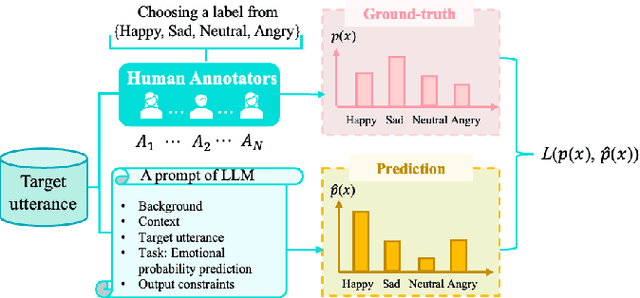
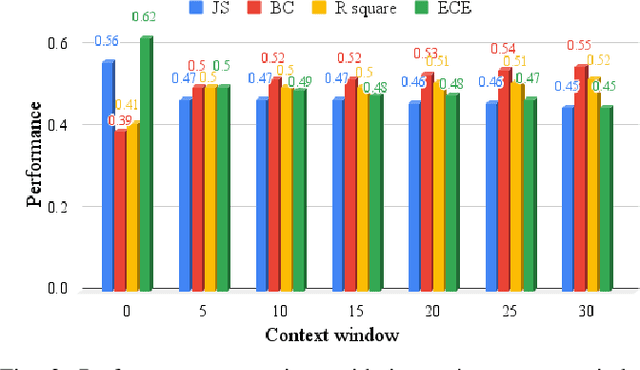
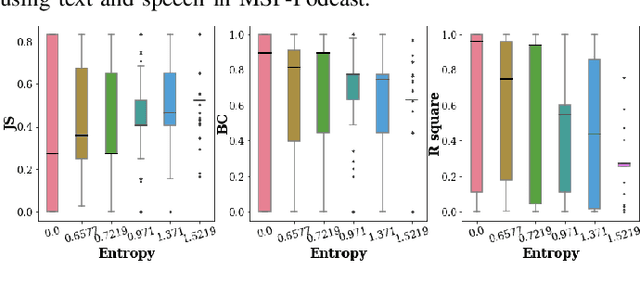
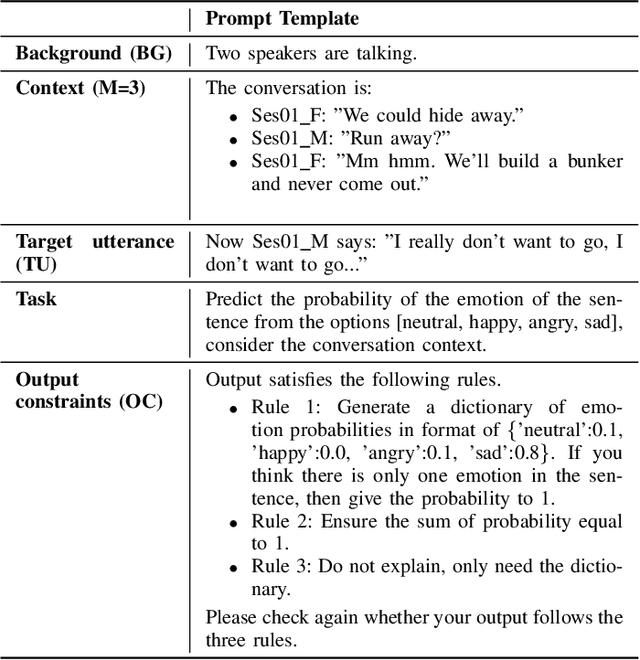
Abstract:Recent advancements in Large Language Models (LLMs) have demonstrated great success in many Natural Language Processing (NLP) tasks. In addition to their cognitive intelligence, exploring their capabilities in emotional intelligence is also crucial, as it enables more natural and empathetic conversational AI. Recent studies have shown LLMs' capability in recognizing emotions, but they often focus on single emotion labels and overlook the complex and ambiguous nature of human emotions. This study is the first to address this gap by exploring the potential of LLMs in recognizing ambiguous emotions, leveraging their strong generalization capabilities and in-context learning. We design zero-shot and few-shot prompting and incorporate past dialogue as context information for ambiguous emotion recognition. Experiments conducted using three datasets indicate significant potential for LLMs in recognizing ambiguous emotions, and highlight the substantial benefits of including context information. Furthermore, our findings indicate that LLMs demonstrate a high degree of effectiveness in recognizing less ambiguous emotions and exhibit potential for identifying more ambiguous emotions, paralleling human perceptual capabilities.
Dual-Constrained Dynamical Neural ODEs for Ambiguity-aware Continuous Emotion Prediction
Jul 31, 2024Abstract:There has been a significant focus on modelling emotion ambiguity in recent years, with advancements made in representing emotions as distributions to capture ambiguity. However, there has been comparatively less effort devoted to the consideration of temporal dependencies in emotion distributions which encodes ambiguity in perceived emotions that evolve smoothly over time. Recognizing the benefits of using constrained dynamical neural ordinary differential equations (CD-NODE) to model time series as dynamic processes, we propose an ambiguity-aware dual-constrained Neural ODE approach to model the dynamics of emotion distributions on arousal and valence. In our approach, we utilize ODEs parameterised by neural networks to estimate the distribution parameters, and we integrate additional constraints to restrict the range of the system outputs to ensure the validity of predicted distributions. We evaluated our proposed system on the publicly available RECOLA dataset and observed very promising performance across a range of evaluation metrics.
Speech Emotion Recognition Via CNN-Transforemr and Multidimensional Attention Mechanism
Mar 07, 2024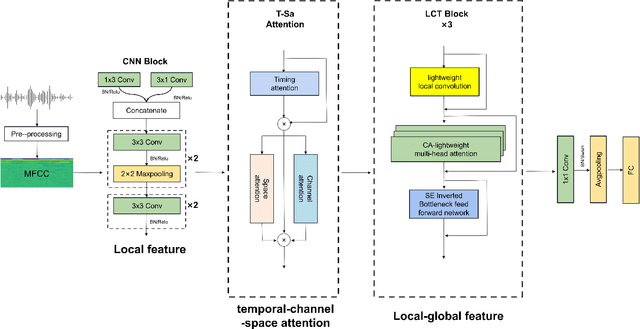

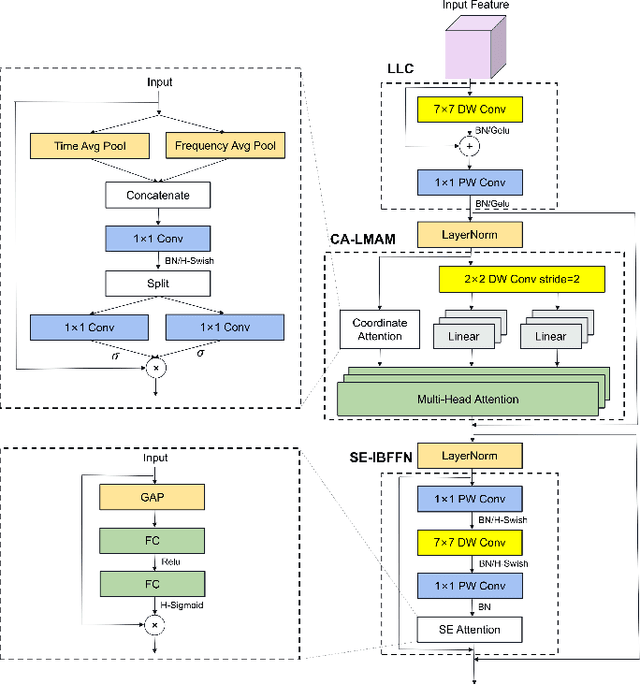
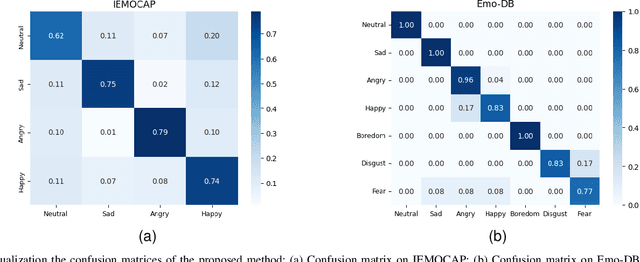
Abstract:Speech Emotion Recognition (SER) is crucial in human-machine interactions. Mainstream approaches utilize Convolutional Neural Networks or Recurrent Neural Networks to learn local energy feature representations of speech segments from speech information, but struggle with capturing global information such as the duration of energy in speech. Some use Transformers to capture global information, but there is room for improvement in terms of parameter count and performance. Furthermore, existing attention mechanisms focus on spatial or channel dimensions, hindering learning of important temporal information in speech. In this paper, to model local and global information at different levels of granularity in speech and capture temporal, spatial and channel dependencies in speech signals, we propose a Speech Emotion Recognition network based on CNN-Transformer and multi-dimensional attention mechanisms. Specifically, a stack of CNN blocks is dedicated to capturing local information in speech from a time-frequency perspective. In addition, a time-channel-space attention mechanism is used to enhance features across three dimensions. Moreover, we model local and global dependencies of feature sequences using large convolutional kernels with depthwise separable convolutions and lightweight Transformer modules. We evaluate the proposed method on IEMOCAP and Emo-DB datasets and show our approach significantly improves the performance over the state-of-the-art methods. Our code is available on https://github.com/SCNU-RISLAB/CNN-Transforemr-and-Multidimensional-Attention-Mechanism
Variational Connectionist Temporal Classification for Order-Preserving Sequence Modeling
Sep 21, 2023Abstract:Connectionist temporal classification (CTC) is commonly adopted for sequence modeling tasks like speech recognition, where it is necessary to preserve order between the input and target sequences. However, CTC is only applied to deterministic sequence models, where the latent space is discontinuous and sparse, which in turn makes them less capable of handling data variability when compared to variational models. In this paper, we integrate CTC with a variational model and derive loss functions that can be used to train more generalizable sequence models that preserve order. Specifically, we derive two versions of the novel variational CTC based on two reasonable assumptions, the first being that the variational latent variables at each time step are conditionally independent; and the second being that these latent variables are Markovian. We show that both loss functions allow direct optimization of the variational lower bound for the model log-likelihood, and present computationally tractable forms for implementing them.
 Add to Chrome
Add to Chrome Add to Firefox
Add to Firefox Add to Edge
Add to Edge